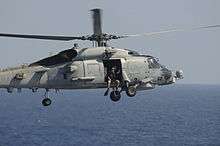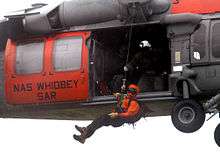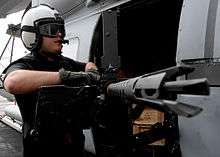Naval aircrewman
The Naval Aircrewman rating (known as Aviation Warfare Systems Operator or AW prior to 2008) is an enlisted rating of the US Navy. It was previously designated as aviation anti-submarine warfare operator. However, under the CNO-directed "Helicopter Master Plan", all 78XX and 94XX aircrewmen were re-designated as "aviation warfare systems operators". The description of the Naval Aircrew Rate (AW) on this page define only the "Active Duty" aspects of the AW rate, fleets (aircraft), positions, and duties that are manned by aircrew in today's Navy. The Full Time Support (FTS) and Selected Reserves (SELRES) components of the U.S. Naval Reserves make up the largest number of Aircrew in today's Navy. Many technologically advanced navies have a similar trade.

| Naval Aircrewman | |
|---|---|
 Naval Aircrewman rating insignia | |
| Issued by | United States Navy |
| Type | Enlisted rating |
| Abbreviation | AW |
| Specialty | Aviation |
Training
All AWs must attain a minimum amount of education and training in several fields of science, technology, and aviation at several different schools. The educational "pipeline" averages 18 months to 2 years in length. The following list describes most of those schools:
Schools
Naval Aircrew Candidate School (NACCS)
Naval Aircrew Candidate School (NACCS), at NAS Pensacola, Florida, trains and evaluates AW students in basic flight physiology and water survival. The course includes low-pressure hypobaric chamber training, night-vision evaluations, multi-station spatial-disorientation device (also known as the "spin and puke") training, and aircraft-emergency-water-egress device. The curriculum also includes advanced first aid and CPR and physical training with road runs up to 2–4 miles and one-mile swims.
AW “A” School
Naval Air Technical Training Center (NATTC) provides accession students a basic introduction to the fundamentals the student must be well versed in to operate on their prospective platform. Active and passive electronic warfare, active and passive sonar. Reading sonograms, magnetic anomaly detection equipment, physics, wave propagation, oceanography, meteorology and working with classified information are included in this phase of training.
Survival, Evasion, Resistance and Escape (SERE)
The Survival, Evasion, Resistance and Escape (SERE) course is designed to provide Level "C" Code of Conduct training to pilots, flight officers, intelligence officers, aircrew, and other designated high-risk-of-capture personnel, as directed by respective TYCOMs/MCCDC in accordance with DOD Instruction 1300.21 and the Joint Personnel Recovery Agency (JPRA) executive agent instruction. Training encompasses those basic skills necessary for worldwide survival, facilitating search-and-rescue efforts, evading capture by hostile forces, resistance to interrogation, exploitation, and indoctrination, and escape from detention by enemy forces, in accordance with DOD Instruction 1300.21. It is based on and reinforces the values expressed in the code of conduct while maintaining an appropriate balance of sound educational methodology and realistic/stressful training scenarios.
Participation in SERE training requires certification of a current physical examination (within 1 year for aircrew) and completion of a medical-screening form within 14 days of training by competent medical authority (i.e., flight surgeon, IDC). If students report for training without medical and dental records, they are dis-enrolled from the course. Because SERE training is physically demanding, students must comply with their own service's body fat standards and have successfully passed their most recent physical-readiness test.
Fleet Replacement Aircrew Training (FRAC)
This phase of training immerses the student much further into training for their specific platform and specialty. Typically, the student will report to an East Coast or West Coast Fleet Replacement Squadron (FRS) to conduct training. Naval Air Training and Operating Procedures Standardization (NATOPS) and tactics are also introduced. After completion of training and reporting for duty in the fleet, they are required to complete “on the job training” lasting around six months before being recognized as fully qualified.
Position summaries
There are several platforms (fixed wing P-3 Orion and rotary wing SH-60 Seahawk aircraft, aircraft carriers, etc.) specialties and special certifications available within the rating. Additional training can be acquired to qualify rotary wing AWs as combat search and rescue swimmers. Below is a list of specialties within the rating.
Aviation Rescue Swimmer (AIRR)

(abbreviated as AWS/AWR)
These Aircrewmen have successfully completed Rescue Swimmer School (RSS) along with the multiple schools in the training pipeline. According to multiple sources, the average pipeline graduation rate is 22%. Sailors who choose this career path need to possess above-average maturity and the ability to stay calm in high-stress situations. AIRR's are trained in basic emergency medicine, rappelling, and various other skills other AW's will not receive. They share many similarities to Coast Guard Aviation Survival Technicians. They are often utilized in humanitarian, combat, and peacetime missions. On average, with both the pipeline and required on-the-job training, it takes about two years to become a qualified AIRR. The Training Pipeline is as follows:

- Aircrew Candidate School (3 weeks)
- Rescue Swimmer School (5 weeks)
- "A" School (7 weeks for AWS, 14 weeks for AWR)
- S.E.R.E. (2 weeks)
- Fleet Replacement Squadrons (6-12 months at assigned Air Station)
AIRR Tactical Helicopter
(abbreviated as AWR)
AWRs go through NACCS and Rescue Swimmer Schools as well, then split off into their own pipeline from there. Going to A-School (13 weeks), FRAC(about 1 year long), SERE (2 weeks). AWRs perform the same jobs as regular AIRR crewman (AWS) as well as locating submarines using acoustics sensors, which has earned them the nickname "Subhunters". They also perform various Surface Warfare missions using Radar and other sensors on board the aircraft.
C-2A Loadmaster
These AWFs fly on the C-2A Greyhound, a carrier-based fixed-wing aircraft. They fly high priority passengers, cargo, and mail to and from aircraft carriers. Their designations as loadmasters start from FRAC school at VAW-120 in Norfolk, Virginia where they become transport second crewman. From there these AWs complete on the job training, their NAWS package, and a second crewman board to become carrier transport second crewman. And then finally completing more job specific qualifications to become a carrier transport crew chief. These AWF's are also highly skilled and qualified in the maintenance program and work hand in hand with their maintenance work centers to better improve their knowledge of the aircraft.

Naval Aircrewman (operator)
- Aboard aircraft
- Note: abbreviated as AWO, SS1, & SS2
These AWs fly in a fixed wing, long range patrol aircraft. Currently the P-3 Orion is fulfilling this role, with the P-8 Poseidon planned to take over this mission starting in 2013. Acoustic sensor operators begin their career in the fleet after attending specialized training. They start as sensor operator 2, and after sufficient flight and related experience is acquired, advance to sensor operator 1 with their own crew. The job can be related to the civilian fields of machine condition monitoring, or predictive maintenance. The AW is responsible for the analysis of all sensor data and must interpret this data in order to search for, localize and track, determine spatial orientation and vector, identify, assess condition of, establish attack parameters on a single, or multiple surface or subsurface contacts. These systems include but are not limited to passive sonar used to listen to underwater sounds, active sonar systems which can be used to pinpoint targets. They control the type and settings for the sonobuoys, underwater communication equipment for platform to platform communication, sensor system to fire control system data transfer and recording.
- Aboard aircraft
- Note: abbreviated as AWO, SS3

Non-acoustic AWs, also known as "sensor 3s" or electronic warfare operators, (EWO's), currently fly in P-3 Orion aircraft, they will be transitioning to the P-8A Poseidon beginning in 2013. Non-acoustic AWs are responsible for operating the radar, electronic support measures system, electro-optical/infrared imaging devices and magnetic anomaly detection device aboard variants of the P-3 Orion. They acquire data necessary to identify surface or air contacts, and can also provide data to help search, localize, and track contacts of interest. SS3s aid in establishing attack parameters on a single, or multiple surface contact. Non-acoustic operators also work with the flight station and navigator to ensure safety-of-flight conditions are maintained.
- Aboard ship or on land
- Note: abbreviated as ASWMOD/ASWOC
These AWs brief and debrief aircrews, filter through, organize, and relay intelligence collected during the mission in an aircraft carrier ASW module (ASMOD) or in a land-based ASW operations center (ASWOC). They coordinate ASW information-gathering throughout the battle group, operate various under-sea warfare and non-under-sea warfare related sensor systems to extract, analyze and classify data obtained; perform specified pre-flight, in-flight and post-flight operations in a multitude of naval aircraft serving anti-surface, USW, mine countermeasures, electronic, counter-narcotics, and land and sea rescue missions performance; operate tactical support center systems to analyze and classify USW and non-USW data; assist in aircrew briefing and debriefing; and provide data base information to the tactical commander for use in prescribing mission objectives and tactics.
Previous platforms
Past AW-crewed aircraft include aircraft carrier-based S-3 Viking and S-2 Tracker aircraft. They also flew in SH-3 Sea King and SH-2 Seasprite helicopters and P-2 Neptune patrol aircraft.
Roots of the rating
The "naval aircrewman" rating was originally called the "Aviation Antisubmarine Warfare Operator" rating (AW) and was established on 1 Sep 1968 by BuPers Note 1440 of 29 Feb 1968 and was redesignated Aviation Warfare Systems Operator by BuPers Note 1440 of 16 Nov 1993, without change of abbreviation. NavAdmin 092/05 of 2 May 2005 directed the consolidation of Enlisted Naval Aircrew (NAC) ratings into Naval Aircrewman (AW) with five subspecialities and eliminated the Aviation Warfare Systems Operator designation. [2]
See also
References
- "Navy enlisted manpower and personnel classifications" (PDF). Bureau of Naval Personnel. US Navy. Archived (PDF) from the original on 25 March 2009. Retrieved 2009-04-23.
- Navy Personnel Command
United States Naval Aviation 1910–1995, Appendix 14, Aviation Ratings Naval Historical Center http://www.navytimes.com/news/2008/05/navy_aircrewrating_052708w/